

The Competing Values Framework. Explanations > Culture > The Competing Values Framework Cultural dimensions | Competing Values | OCAI | So what?
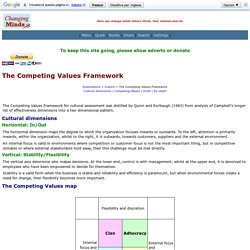
The Competing Values Framework for cultural assessment was distilled by Quinn and Rorbaugh (1983) from analysis of Campbell's longer list of effectiveness dimensions into a two dimensional pattern. Cultural dimensions Horizontal: In/Out The horizontal dimension maps the degree to which the organization focuses inwards or outwards. An internal focus is valid in environments where competition or customer focus is not the most important thing, but in competitive climates or where external stakeholders hold sway, then this challenge must be met directly. Vertical: Stability/Flexibility The vertical axis determine who makes decisions.
Stability is a valid form when the business is stable and reliability and efficiency is paramount, but when environmental forces create a need for change, then flexibility becomes more important. The Competing Values map Hierarchy Market Clan Adhocracy. “You can’t change corporate culture.” Yes, you can. Organizations come to The Ken Blanchard Cos. to have us help them make their organizations better.

“Better” might mean more effective leadership, higher performance, improved customer experiences, greater net profit or a more cooperative, positive work environment. Organizations come to us because they see missed opportunities in their operations. They might see less-than-inspiring leadership happening each day. They might see less-than-inspired employees every day. They have gaps they want to close, and they know Blanchard can help them do that. After a thorough assessment of a client’s current operation and clarification of needs, we are able to present solutions that we’re confident will address their gaps. Some clients readily embrace our solutions. How workplace culture can help drive employees to succeed.
How would you describe your organization/department/team’s culture?

Take a moment and select three words or phrases that describe your company culture. Write them down and set them aside; we’ll come back to them in a few paragraphs. If you’re like most leaders, you don’t pay careful attention to the work environment that exists in your organization today. Most leaders have been groomed to focus primarily on performance metrics, things such as net profit, market share, EBIDA, payroll expenses, etc.
10 Ways to Build a Business Culture Like Apple. 6 Roadblocks That May Be Holding Back Your Company Culture. Company culture is becoming more and more instrumental when it comes to hiring and retaining top talent.
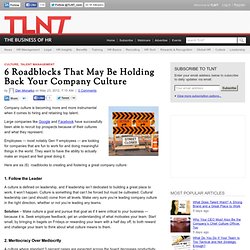
Large companies like Google and Facebook have successfully been able to recruit top prospects because of their cultures and what they represent. Employees — most notably Gen Y employees — are looking for companies that are fun to work for and doing meaningful things in the world. Trying to Change Your Corporate Culture? Here Are 3 Lessons to Remember. Company culture is much in the news these days, a development I am very excited to see as it shows more and more buy-in to the importance of culture as something that can be created and, yes, proactively managed.
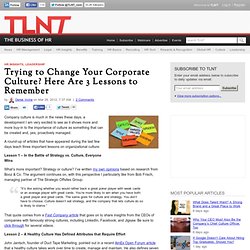
A round-up of articles that have appeared during the last few days teach three important lessons on organizational culture: Lesson 1 – In the Battle of Strategy vs. Culture, Everyone Wins. Manage the Culture Cycle. By James L.

Heskett “Organizational culture – the shared assumptions, values, and behaviors that determine “how we do things around here” really matters.” Culture Eats Strategy For Lunch. Get on a Southwest flight to anywhere, buy shoes from Zappos.com, pants from Nordstrom, groceries from Whole Foods, anything from Costco, a Starbucks espresso, or a Double-Double from In N' Out, and you'll get a taste of these brands’ vibrant cultures.

Culture is a balanced blend of human psychology, attitudes, actions, and beliefs that combined create either pleasure or pain, serious momentum or miserable stagnation. A strong culture flourishes with a clear set of values and norms that actively guide the way a company operates. Employees are actively and passionately engaged in the business, operating from a sense of confidence and empowerment rather than navigating their days through miserably extensive procedures and mind-numbing bureaucracy. Performance-oriented cultures possess statistically better financial growth, with high employee involvement, strong internal communication, and an acceptance of a healthy level of risk-taking in order to achieve new levels of innovation. Three Steps to a High-Performance Culture - Carolyn Dewar and Scott Keller. By Carolyn Dewar and Scott Keller | 10:52 AM January 26, 2012 Senior executives tend to think about corporate culture as a topic that’s hard to measure and hard to change.

As a result, many choose not to invest in it despite all the evidence that, when skillfully managed, culture can be a powerful and enduring source of competitive advantage. ANZ Bank offers an example: a decade ago, the bank embarked on an effort described as a “unique plan of eschewing traditional growth strategies and recasting the culture of the bank to lift efficiency and earnings.” In the initial two years, the share of employees having the sense that ANZ “lived its values” went from 20 to 80 percent, and the share seeing “productivity in meetings” from 61 to 91 percent, with similar rises in the shares seeing “openness and honesty” and a “can-do culture.”
In parallel, revenue per employee increased 89 percent and the bank overtook its peers in total returns to shareholders and customer satisfaction. Three Steps to a High-Performance Culture — from HBR Blog Network « Benefit Point. Visual courtesy eriardu.blogspot.com Having been involved in two organisational change management projects, I found the following article extremely helpful from the perspective of the importance corporate culture has in driving an organisation’s ability in achieving its goals & in having metrics that (finally) enables measurement of corporate culture.
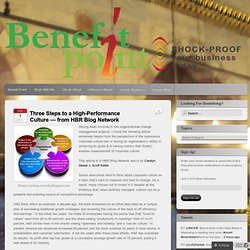
This article is in HBR Blog Network and is by Carolyn Dewar & Scott Keller. Senior executives tend to think about corporate culture as a topic that’s hard to measure and hard to change. To Change the Culture, Stop Trying to "Change the Culture" - Robert H. Schaffer. By Robert H.
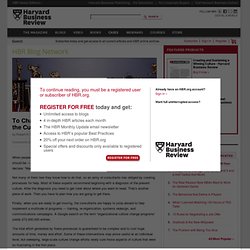
Schaffer | 11:00 AM December 6, 2012 When people aren’t achieving what they should be achieving and things aren’t going the way they should be — and if senior managers can’t pin the blame on some specific issue — they often declare: “We have to change the culture around here.” Not many of them feel they know how to do that, so an army of consultants has obliged by creating processes for help. Most of these experts recommend beginning with a diagnosis of the present culture. Creating Culture Change That Sticks. Wednesday, July 18th, 2012 - 16:49 Wednesday, July 18, 2012 - 16:46 How does a leader change the culture of an organization that is resistant to change? Start by working with the existing culture, says business writers in a recent Harvard Business Review article.
Five Critical Questions About Organization Culture That People Avoid Asking. There is a piece on HBR Blog on the topic of organization culture “Culture Takes Over When the CEO Leaves the Room” by Frances Frei and Anne Morriss (both HBS professors). It is a good piece worth reading and here's an summary of their ideas: Excellence = design x culture. Three Keys to Sustaining Culture Change. I read an excellent post by author Mark Miller recently about what it takes to create a leadership culture. It couldn’t have been more spot on. To create a winning leadership culture, according to Miller, you must define it, train it, practice it, measure it, and model it.
Want I want to add is another dimension on how to position your organization to sustain the culture changes you wish to implement. A Good Way to Change a Corporate Culture - Peter Bregman. By Peter Bregman | 1:53 PM June 25, 2009 “I’d like to talk to you about a big project,” the woman told me on the phone. “We need to change our culture.” She was a senior leader in a professional services firm, where people really are their most important asset. Only it turns out the people weren’t so happy. Theirs was a very successful firm with high revenues, great clients, and hard working employees.
This firm had developed a reputation for being a terrible place to work. He paused and then continued, “I’m not proud of that story, but it’s how we’ve always operated the firm.” Such a simple question. You Can't Dictate Culture — but You Can Influence It - Ron Ashkenas. By Ron Ashkenas | 10:55 AM June 21, 2011 There’s an old joke about a CEO who attended a presentation on corporate culture and then asked his head of HR to “get me one of those things.” Of course it sounds ludicrous — but like most jokes, this story is based in truth.
Many organizations treat the creation, maintenance, and periodic updating of their cultures in a cavalier manner. Either they pay lip service to the kind of culture they want, but don’t do much about it — or worse, ignore culture completely. Most senior managers struggle with culture because it’s so difficult to define. The answer is that you don’t. Leaders however can influence those behaviors in several ways — and by so doing shape the culture of their firms. Convey your vision of a winning culture. Demonstrate how new cultural behaviors can advance the business. Put teeth into the new culture by integrating it into HR processes.